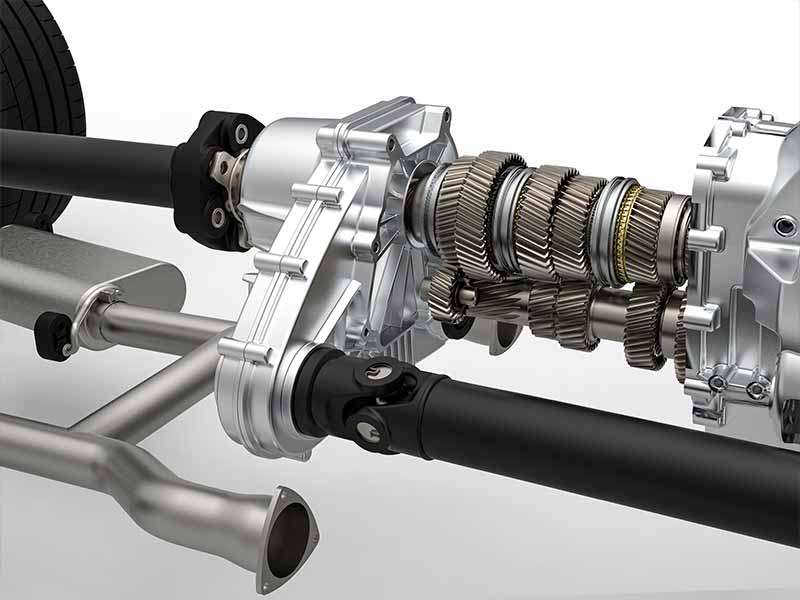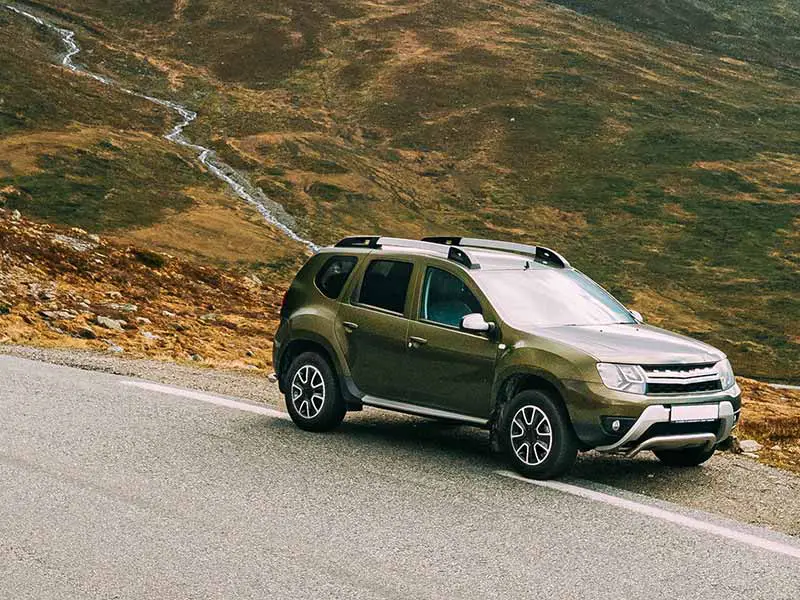Ever wondered why some cars seem to glide effortlessly on icy roads while others struggle to climb a wet hill? Or why some vehicles can handle rugged off-road trails, while others are built for smooth city streets? The secret lies beneath the car, in the part that controls the tires – the drivetrain.
FWD, RWD, AWD, 4WD, 2WD Drivetrains
Drivetrains, including Front-Wheel Drive (FWD), Rear-Wheel Drive (RWD), All-Wheel Drive (AWD), Four-Wheel Drive (4WD), and Two-Wheel Drive (2WD), each have their unique pros and cons.
These variations affect traction, handling, fuel efficiency, maintenance costs, and overall driving experience.
In this article, we’ll dive into each of these drivetrains, exploring what they are, their key advantages, and disadvantages. We’ll take you on a journey from the comfortable front-wheel cruisers to the rugged four-wheel adventurers, providing insights that will help you choose the perfect drivetrain for your needs.
Let’s take a closer look.

What is Front-Wheel Drive (FWD)?
Front-Wheel Drive, or FWD as we often call it, is a setup where the engine’s power is sent directly to the front wheels of your vehicle. That’s right, your car is pulled forward by its front tires! This type of drivetrain is found in many cars today because of its simplicity and efficiency.
Key Advantages of FWD
Front-Wheel Drive systems have some really cool benefits that make them a popular choice for many drivers. Let’s take a closer look at some of these:
- Easier Handling in Certain Weather Conditions:
- Since the weight of the engine is over the driving wheels, FWD vehicles generally offer better traction on slippery surfaces like wet or snowy roads. It’s like having a heavyweight champion wrestler in your car’s corner, helping you stay on the track!
- Improved Gas Mileage:
- FWD systems are lighter than other drivetrains, which means your car doesn’t have to work as hard to move around, and you save money at the gas pump. In other words, your vehicle gets to enjoy a healthy diet!
- Lower Cost for Production and Maintenance:
- FWD systems are simpler to build and install, which translates to a lower sticker price for you. Not only that, but they’re generally easier to maintain, saving you money in the long run.
Key Disadvantages of FWD
Just like everything else in life, FWD systems have a couple of downsides. Here they are:
- Less Balanced Weight Distribution:
- Most of the weight in a FWD vehicle is located in the front. This can make the car feel less balanced, especially when accelerating quickly or going around fast corners. It’s kind of like trying to run a race with a heavy backpack!
- More Wear on Front Tires:
- Since your front tires are doing all the work – steering, accelerating, and most of the braking, they can wear out more quickly than the rear ones. Imagine doing all the chores at home, you’d feel tired too, right?
What is Rear-Wheel Drive (RWD)?
Rear-Wheel Drive, lovingly known as RWD, is where the engine powers the back wheels of the vehicle. Unlike FWD where your car is pulled forward, in an RWD setup, your vehicle is pushed from behind. It’s a bit like having a strong friend give you a helpful shove on a skateboard!
Key Advantages of RWD
RWD systems have been around for a long time, and they’ve got some impressive benefits up their sleeve. Here are a few:
- Superior Handling and Acceleration:
- Because RWD cars distribute the work of the car (steering and accelerating) between the front and rear wheels, they can provide better handling and acceleration. It’s like having a team, where each member has a specific job!
- Better Weight Distribution:
- RWD cars have more balanced weight distribution, which can make them feel more stable and responsive when you’re steering or picking up speed.
- Less Wear on Front Tires:
- Since the front tires aren’t doing all the work (like in FWD cars), they can often last longer. So, fewer pit stops for your car!
Key Disadvantages of RWD
Even with all their advantages, RWD systems aren’t perfect. Let’s check out some of their drawbacks:
- Poor Performance in Slippery Conditions:
- RWD cars can sometimes struggle on wet or snowy roads because the weight over the drive wheels (the back ones) is lighter. Think about it like trying to push a shopping cart across an icy parking lot, it can go a little sideways!
- Higher Maintenance Cost:
- RWD systems can be more complex, which can mean more expensive repairs if something goes wrong. Like owning a fancy gadget, it’s cool, but can cost you if it breaks!
What is All-Wheel Drive (AWD)?
All-Wheel Drive, or AWD, is a type of drivetrain that delivers power from the engine to every wheel of your vehicle. It’s like having a whole team of friends giving your car a push and a pull, from all sides, at the same time!
Key Advantages of AWD
AWD has some strong points that make it a great choice, especially for certain types of driving. Let’s dive into some of these:
- Improved Traction in All Kinds of Conditions:
- AWD systems are designed to automatically adjust the power to each wheel. This can give you better grip and control whether you’re driving on a sunny day, navigating a heavy downpour, or even tackling a snowy road. It’s like having all-weather sneakers for your car!
- Enhanced Stability and Handling:
- Because all the wheels are powered in an AWD vehicle, it can provide better handling and stability, especially in tricky situations. It’s kind of like having extra hands to catch a ball!
Key Disadvantages of AWD
AWD sounds pretty great, right? But it’s not all sunshine and rainbows. There are a few downsides to consider:
- Higher Fuel Consumption:
- AWD systems can be heavier and more complex, which can make your car guzzle more gas. It’s a bit like carrying a heavy backpack – it makes you tired quicker.
- More Complex, Hence Costlier to Repair:
- Because there are more parts in an AWD system, repairs can be more complicated and pricier. It’s like having a computer with all the latest features – amazing to use, but costly if something goes wrong!
What is Four-Wheel Drive (4WD)?
Four-Wheel Drive, better known as 4WD or 4×4, is a type of drivetrain that can deliver power to all four wheels of your vehicle at the same time. It’s like having a super-powered team of friends who can give your car a giant push, especially when you’re off-roading or driving on tricky terrain!
Key Advantages of 4WD
4WD systems are the big, burly superheroes of drivetrains. They’re especially useful in certain situations. Here are a couple of advantages:
- Great for Off-Road Conditions:
- Whether you’re tackling a muddy trail, climbing steep hills, or traversing sandy dunes, a 4WD system is designed to handle tough, off-road conditions. It’s like having a rugged pair of hiking boots for your vehicle!
- Can Be Turned Off to Save Fuel:
- Many 4WD vehicles let you switch to two-wheel drive when you don’t need the extra power. This can help save fuel, making your car’s diet a bit lighter when you’re just cruising down the highway.

Key Disadvantages of 4WD
As impressive as 4WD systems are, they do have a few downsides:
- Not the Best for Regular Road Use:
- On regular roads, a 4WD system can make a vehicle feel heavier and less agile. It’s like wearing heavy-duty winter boots when you’re just strolling around town – they can feel a bit clunky!
- Increased Weight and Fuel Consumption:
- Because of the extra parts needed to power all four wheels, 4WD systems can make a vehicle heavier and thirstier for fuel.
What is Two-Wheel Drive (2WD)?
Two-Wheel Drive, which we often call 2WD, is a drivetrain system where the engine’s power is sent to just two wheels, either the front or the back. It’s the simplest setup, like having just one or two friends helping to push or pull your car.
Key Advantages of 2WD
2WD has been around for a long time, and it has some pretty neat advantages. Let’s take a look:
- Simplicity and Reliability:
- 2WD systems are straightforward and have fewer parts, which can make them more reliable. Imagine a trusty old bicycle—it’s simple, but it gets you where you need to go!
- Lower Cost of Ownership:
- Because they’re simpler, 2WD vehicles tend to be less expensive to buy and to maintain. It’s like choosing a reliable, no-frills cell phone—it does what you need it to do without breaking the bank.

Key Disadvantages of 2WD
Of course, 2WD systems have a few disadvantages too. Here they are:
- Limited Traction in Challenging Conditions:
- Since only two wheels are powered, 2WD vehicles can struggle in tricky conditions like mud, snow, or steep inclines. It’s like trying to walk on ice with regular shoes—you might have a hard time staying upright!
- Not Ideal for Off-Road or Heavy-Duty Tasks:
- If you’re into off-roading or need to haul heavy loads, a 2WD vehicle might not be the best choice. It’s a bit like trying to use a regular backpack for a week-long camping trip—it’s just not made for that kind of heavy lifting!
Resources
Below are some links you may find helpful when learning about tires
- How it works: 2wd vs. awd vs. 4wd – Consumer Reports
- Awd, fwd, or rwd-Which wheel drive is best? – Motor Trend
Final Thoughts
From the simplicity and efficiency of Front-Wheel Drive (FWD) and Two-Wheel Drive (2WD) systems, to the balanced performance of Rear-Wheel Drive (RWD), and the off-road prowess of Four-Wheel Drive (4WD), each has its unique strengths and weaknesses. Remember, All-Wheel Drive (AWD) offers adaptable traction and handling, making it a versatile choice for changing conditions.
Choosing the right drivetrain depends on your specific needs – whether it’s fuel efficiency, driving in various weather conditions, tackling off-road adventures, or balancing cost with performance. With this newfound understanding of drivetrains, you are now equipped to make a more informed decision.
Good luck and happy motoring.




